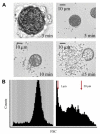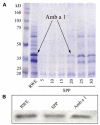Subpollen particles: carriers of allergenic proteins and oxidases
- PMID: 17030236
- PMCID: PMC3079542
- DOI: 10.1016/j.jaci.2006.07.006
Subpollen particles: carriers of allergenic proteins and oxidases
Abstract
Background: Pollen is known to induce allergic asthma in atopic individuals, although only a few inhaled pollen grains penetrate into the lower respiratory tract.
Objective: We sought to provide evidence that subpollen particles (SPPs) of respirable size, possessing both antigenic and redox properties, are released from weed pollen grains and to test their role in allergic airway inflammation.
Methods: The release of SPPs was analyzed by means of microscopic imaging and flow cytometry. The redox properties of SPPs and the SPP-mediated oxidative effect on epithelial cells were determined by using redox-sensitive probes and specific inhibitors. Western blotting and amino acid sequence analysis were used to examine the protein components of the SPP. The allergenic properties of the SPP were determined in a murine model of experimental asthma.
Results: Ragweed pollen grains released 0.5 to 4.5 microm of SPPs on hydration. These contained Amb a 1, along with other allergenic proteins of ragweed pollen, and possessed nicotinamide adenine dinucleotide (reduced) or nicotinamide adenine dinucleotide phosphate (reduced) [NAD(P)H] oxidase activity. The SPPs significantly increased the levels of reactive oxygen species (ROS) in cultured cells and induced allergic airway inflammation in the experimental animals. Pretreatment of the SPPs with NAD(P)H oxidase inhibitors attenuated their capacity to increase ROS levels in the airway epithelial cells and subsequent airway inflammation.
Conclusions: The allergenic potency of SPPs released from ragweed pollen grains is mediated in tandem by ROS generated by intrinsic NAD(P)H oxidases and antigenic proteins.
Clinical implications: Severe clinical symptoms associated with seasonal asthma might be explained by immune responses to inhaled SPPs carrying allergenic proteins and ROS-producing NAD(P)H oxidases.
Figures






References
-
- Grote M. In situ localization of pollen allergens by immunogold electron microscopy: allergens at unexpected sites. Int Arch Allergy Immunol. 1999;118:1–6. - PubMed
-
- Vrtala S, Grote M, Duchene M, van Ree R, Kraft D, Scheiner O, et al. Properties of tree and grass pollen allergens: reinvestigation of the linkage between solubility and allergenicity. Int Arch Allergy Immunol. 1993;102:160–9. - PubMed
-
- Suphioglu C, Singh MB, Taylor P, Bellomo R, Holmes P, Puy R, et al. Mechanism of grass-pollen-induced asthma. Lancet. 1992;339:569–72. - PubMed
-
- Schappi GF, Taylor PE, Staff IA, Rolland JM, Suphioglu C. Immunologic significance of respirable atmospheric starch granules containing major birch allergen Bet v 1. Allergy. 1999;54:478–83. - PubMed
Publication types
MeSH terms
Substances
Grants and funding
LinkOut - more resources
Full Text Sources
Miscellaneous

